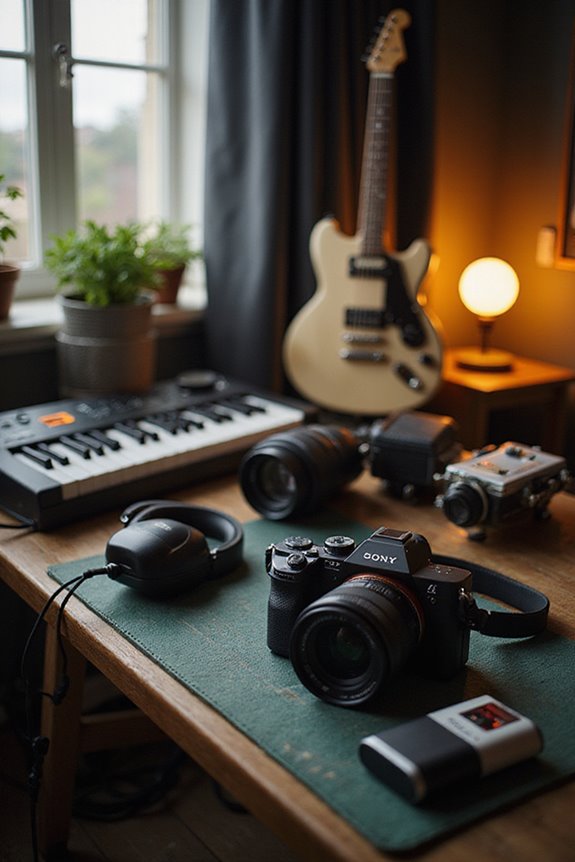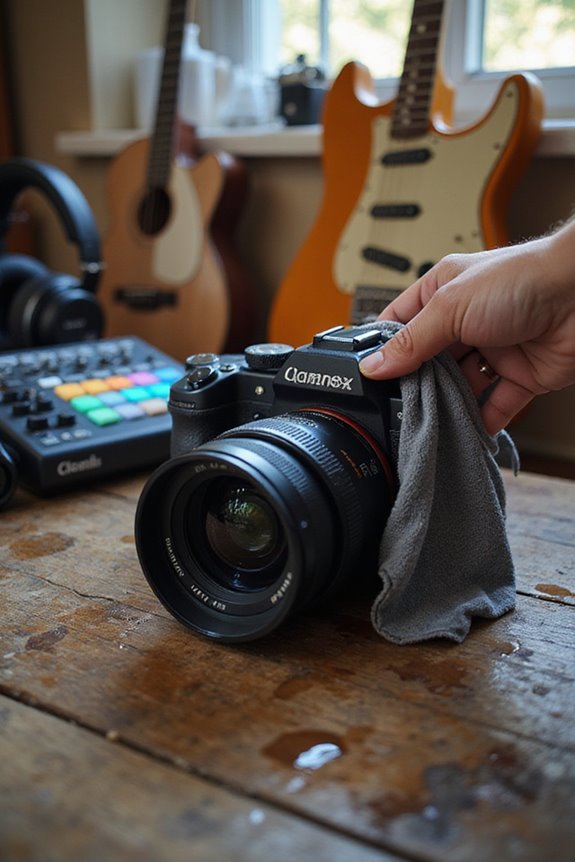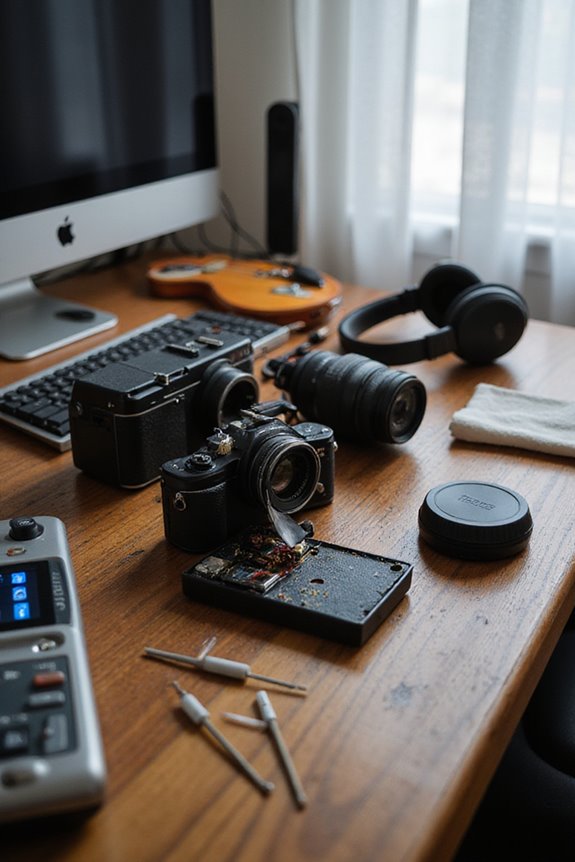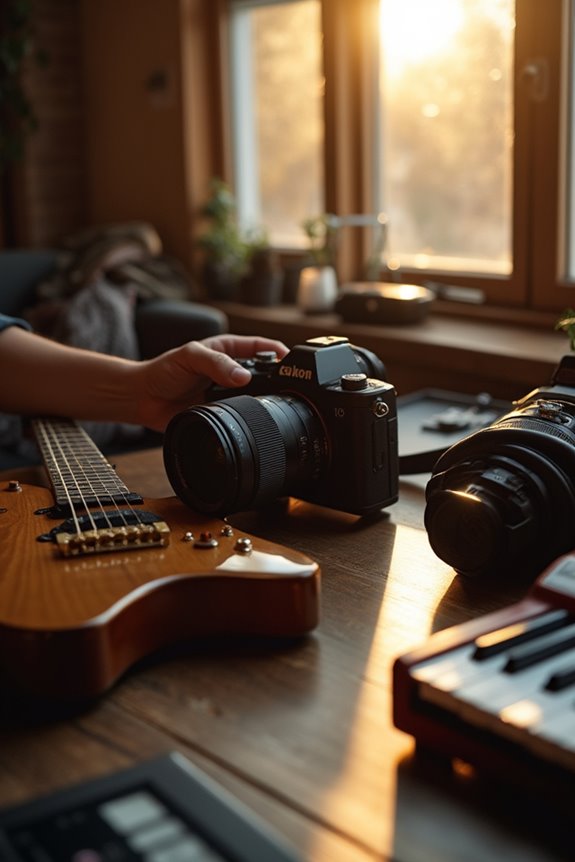When we choose a carbon-fiber tripod, we prioritize its lightweight advantages and superior stability. These tripods are often 30-40% lighter than aluminum, making extended shoots easier on our bodies. The exceptional durability against corrosion and moisture is also essential for outdoor shooting. Additionally, thermal comfort enhances our experience, avoiding extremes in temperature. By evaluating our specific needs and budget, we can make informed decisions that suit our photography style. Let’s explore further insights to optimize our selections.
Key Takeaways
- Consider the weight advantage of carbon fiber tripods, as they are typically 30-40% lighter than aluminum options, reducing fatigue during shoots.
- Evaluate load capacity to ensure the tripod supports your camera setup effectively, especially for heavier equipment or additional accessories.
- Assess durability and weather resistance, as carbon fiber offers exceptional corrosion resistance and stability in harsh conditions.
- Look for low thermal conductivity properties, which keep carbon fiber comfortable to handle in varying temperatures without becoming too hot or cold.
- Compare cost versus performance, as carbon fiber models often justify their higher price with significant weight reductions that benefit adventure photographers.
Understanding Carbon Fiber Material Properties
When it comes to selecting a tripod, understanding the properties of carbon fiber can really influence our choice. This remarkable material is made from thin woven carbon strands combined with epoxy resin, ensuring both strength and rigidity. The unique multi-layer construction not only enhances its durability but also boosts stability under varying loads.
One notable material benefit of carbon fiber is its high stiffness, measured by Young’s modulus, which surpasses that of aluminum. This results in superior resistance to bending and vibrations, making it ideal for long exposures and windy conditions. Plus, carbon fiber’s exceptional resistance to corrosion means our equipment remains reliable, even in harsh weather. Selecting a carbon fiber tripod could greatly elevate our photography game. Additionally, load capacity is an important factor to consider, as it ensures the tripod can support different camera setups effectively.
Weight Advantages for Photographers
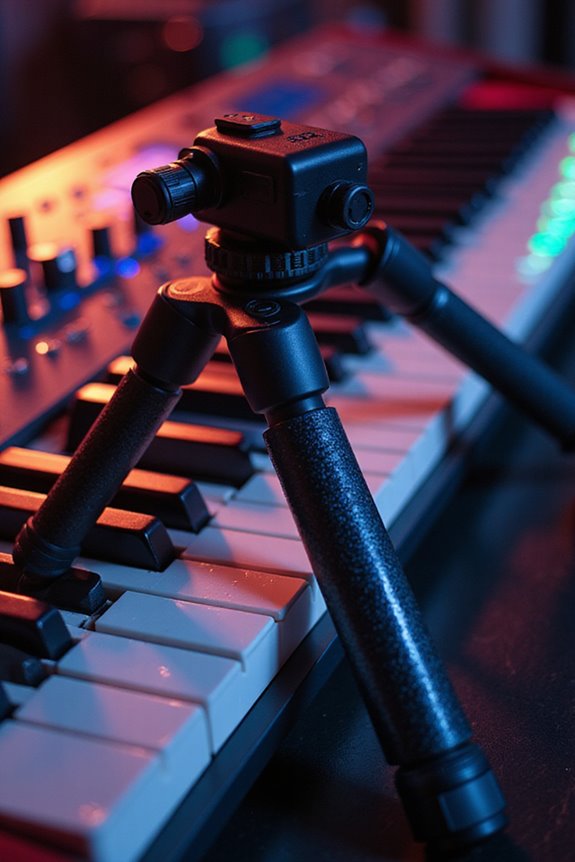
Choosing a tripod that markedly reduces weight can transform our shooting experience. Carbon fiber tripods are about 30-40% lighter than aluminum options, enhancing portability benefits that we’d appreciate on long hikes or while traveling. For instance, a typical aluminum tripod starts at around 2.5 kg, while a carbon fiber model can weigh as little as 1.25 kg. This significant weight reduction means less fatigue during extended shoots and encourages us to bring along essential support equipment without second-guessing our gear choices. Additionally, lightweight designs support compact folding mechanisms, maintaining stability without added bulk. So, embracing a carbon fiber tripod helps us manage our equipment efficiently, keeping our focus on capturing stunning images rather than lugging around heavy gear.
Assessing Durability and Weather Resistance
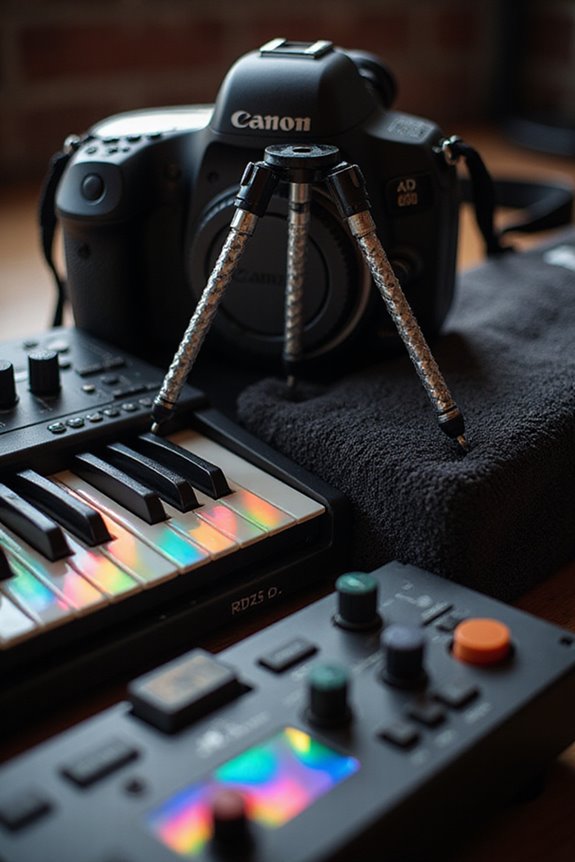
Understanding the durability and weather resistance of carbon fiber tripods can greatly influence our choice, especially for outdoor enthusiasts. Carbon fiber boasts excellent stiffness and structural integrity, making it lighter yet more robust than aluminum. Its resistance to corrosion and moisture means we don’t have to worry about deterioration in humid or salty environments. However, it’s crucial to evaluate impact resistance; while carbon fiber is strong, it can be brittle under severe shocks. Additionally, environmental considerations arise with its production, which is more energy-intensive than aluminum. Regular maintenance, like cleaning sand and salt, can further extend its lifespan, ensuring our tripod withstands the rigors of nature and time.
Thermal Comfort in Varying Conditions
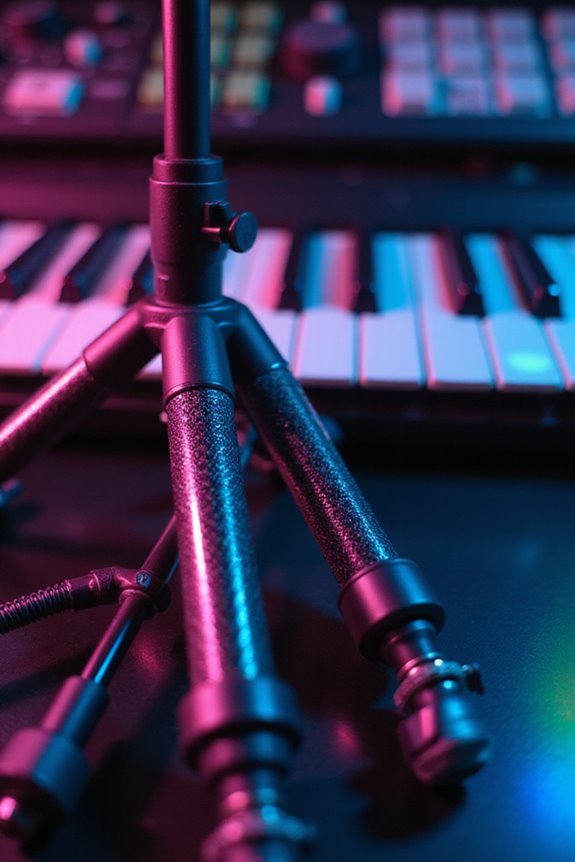
In environments where temperatures can swing dramatically, few things are as essential as thermal comfort for outdoor photographers and videographers. Carbon fiber tripods excel in this area due to their low thermal conductivity. Unlike aluminum, which can become uncomfortably hot or cold, carbon fiber remains comfortable to handle, enhancing our user experience. This thermal insulation means we can work effectively in extreme conditions without needing additional gear like leg wraps to maintain hand comfort. Additionally, the minimal thermal expansion guarantees that our equipment remains stable, allowing us to focus on capturing the perfect shot without worrying about abrupt temperature impacts. Overall, a carbon fiber tripod not only feels better in diverse climates but can also boost our performance on the job.
Evaluating Cost vs. Performance
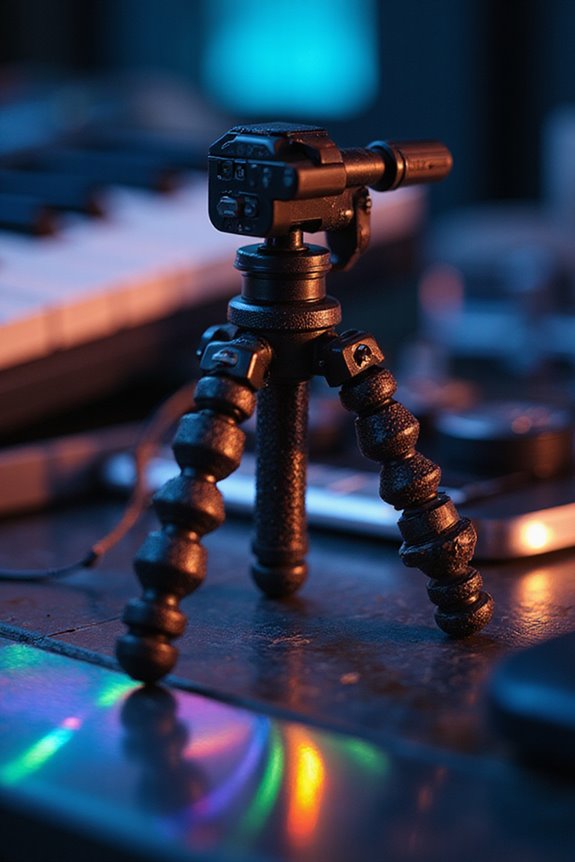
Evaluating the price-to-performance ratio of carbon-fiber tripods reveals key insights that can guide our purchasing decisions. While the allure of carbon fiber is strong, especially for those with professional requirements, we need to weigh our budget considerations carefully. For instance, the Peak Design Travel Tripod retails at $599.95 compared to $379.95 for its aluminum counterpart. If we’re mostly shooting indoors or on short trips, aluminum might offer better stability and cost-effectiveness. However, for adventure photographers who prioritize lightweight gear during long hikes, the carbon fiber’s 20-25% reduction in weight often justifies the higher price. Ultimately, knowing our specific needs helps us choose wisely between budget-friendly options and high-end performance models.
Stability and Rigidity in Tripod Design
When we’re choosing a tripod, stability and rigidity play essential roles in overall performance, particularly in varied shooting conditions. Carbon fiber tripods excel in tripod design due to their exceptional stiffness-to-weight ratio, much greater than aluminum. This means less flex and improved vibration control, important for capturing sharp images during long exposures. For instance, when filming in windy environments, a sturdy carbon fiber model minimizes shake. However, lighter models can be less stable, so it’s imperative to evaluate leg configuration and spread. We should also pay attention to the quality of the locking mechanisms, as these can impact overall rigidity and durability. Ultimately, understanding these aspects leads us to make informed decisions for our photography needs.
Choosing the Right Build Quality
While selecting a tripod, we can’t overlook the importance of build quality, as it greatly impacts our photography experience. High-quality carbon fiber tripods incorporate advanced carbon fiber techniques, employing layered tubes engineered for maximum strength with minimal weight. This guarantees durability and reliability in various weather conditions, essential for outdoor photographers. Premium craftsmanship also includes innovative designs like compact folding mechanisms, enhancing portability without sacrificing functionality. In addition, refined locking mechanisms and leg angle adjustments can greatly influence stability during shoots. When investing in a carbon fiber tripod, considering these aspects of craftsmanship can elevate our photography, assuring that we’re well-equipped for any situation—whether it’s a travel adventure or a complex landscape shoot.
Maintaining Your Carbon Fiber Tripod
Maintaining your carbon fiber tripod is essential to guarantee its longevity and peak performance during your photography adventures. First, let’s adopt effective cleaning techniques. We should use warm water and a gentle dishwashing soap on a soft towel to gently wipe away dirt, avoiding residue. For saltwater exposure, rinse the legs with plain water and dry thoroughly before collapsing.
Next, let’s consider lubrication tips. We should use manufacturer-recommended lubricants on moving parts, ensuring to avoid excess that attracts dirt. Regularly inspect all fasteners for wear, adjusting tension bolts as necessary for smooth operation. Finally, store our tripod in a dry place, and don’t forget to loosen clamps slightly for long-term care. This proactive approach keeps our tripods in top condition!
Frequently Asked Questions
How Much Load Can a Carbon Fiber Tripod Support?
So, we’re not planning to build a skyscraper, right? Generally, carbon fiber tripods support loads ranging from 22 to 60 lbs, depending on weight distribution factors. Just remember, don’t exceed that max load – trust us!
Are Carbon Fiber Tripods Suitable for Heavy Video Equipment?
Absolutely, we find carbon fiber tripods suit heavy video equipment perfectly. Their impressive stability factors and ideal weight considerations allow us to transport and set up with ease, ensuring reliable support for all our gear.
What Is the Average Lifespan of a Carbon Fiber Tripod?
We’ve seen a well-maintained carbon fiber tripod last over two decades, showcasing how tripod maintenance and lifespan factors like usage frequency and storage impact durability. Investing in quality guarantees it can withstand the test of time.
Can I Repair a Damaged Carbon Fiber Tripod?
Yes, we can repair a damaged carbon fiber tripod. With proper tripod maintenance, we enhance carbon fiber durability and extend its lifespan, making DIY fixes a cost-effective option for many common issues we encounter.
Are There Specific Brands Known for Quality Carbon Fiber Tripods?
When we think about top brands for quality carbon fiber tripods, user reviews highlight ProMediaGear, Manfrotto, and Benro. These brands consistently deliver durability and performance, making them favorites among both professionals and enthusiasts alike.

